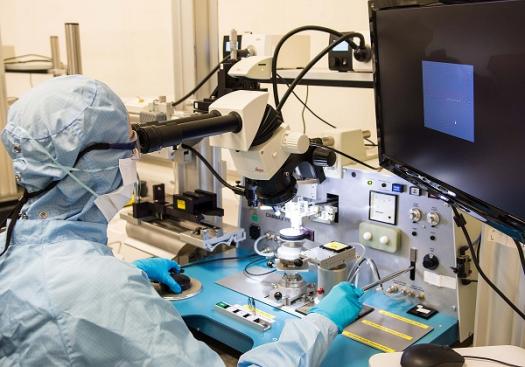Kaiam eyes datacentre growth

As datacentre traffic soars, US photonic integrated circuit pioneer, Kaiam, buys a second UK facility to track growing markets, reports Compound Semiconductor.
MEMS platform: Kaiam's cutting-edge optical transceivers will soon be ready to ship from new UK manufacturing facilities. [Kaiam]
Last month, US-based photonic integrated circuit pioneer, Kaiam, revealed it had agreed to buy the manufacturing facilities of Compound Photonics in Newton Aycliffe, UK.
The move provides much needed manufacturing space for Kaiam's growing lines of optical transceivers. However the new facility also delivers an extensive cleanroom, with three and six inch wafer lines, for processing III-V devices, including pHEMTs, HBTs, photodetectors and lasers.
"The Newton Aycliffe site is a world-class facility in both capabilities and scale for producing III-V devices," highlights Kaiam chief executive, Bardia Pezeshki. "With this we now have everything we need to be the leading manufacturer of future optical transceivers."
Kaiam was founded in 2010, with the goal of commercialising a MEMS-based platform to assemble photonic integrated circuits. Here, the MEMS platform acts as a substrate for individual optical components.
Micro-lenses and solder balls are attached to the platform at locations where optical coupling is required. Optical components, such as InP lasers and modulators, are first loosely mounted onto this platform using conventional assembly tools, and then each micro-lens is automatically oriented via MEMS to optimise alignment.
In this way, the entire assembly can be precisely aligned to meet the tight tolerances demanded by the optical communications industry for applications, such as optical transceivers.
Following several rounds of funding and successful transceiver demonstrations, Kaiam acquired the Scotland-based facilities of its silicon-based planar lightwave circuit (PLC) supplier, Gemfire, in 2013. Kaiam quickly established silica-on-silicon lines at the facility and started manufacturing its 'SCOTS' - Silicon Carrier for Optical Terabit Systems - PLCs.
Crucially, vertical integration meant the company could combine integrated optical components fabrication with its MEMS-based platform and swiftly ship 40G and 100G transceivers demanded by the likes of Amazon, Facebook, Microsoft and Google for datacentres.
Fast forward four years and the demand for bandwidth from datacentres continues to grow. As Pezeshki highlights: "There is so much more machine-to-machine traffic now which means the demand for bandwidth within the datacentre is enormous."
And as the chief executive adds, four years ago' industry optical communication speeds leapt from 10Gbit/s to 40Gbit/s. "We rode that wave and that fueled growth," he says. "So now we are moving from 40Gbit/s to 100Gbit/s, and we're making 100G transceivers out of Livingston [Scotland]."
But Livingston is out of space. Clearly Kaiam's precision approach has met with success and as the demand for datacentre transceivers soars, so the company needs to keep pace; cue Newton Aycliffe.
As Pezeshki says: "Our existing manufacturing facility in Livingston is full so the Newton Aycliffe facility provides us with the space we need to expand into almost immediately."
![]() MOCVD reactor for III-V materials growth: Kaiam will use the instrument to develop and manufacture InP PICs.
MOCVD reactor for III-V materials growth: Kaiam will use the instrument to develop and manufacture InP PICs.
The company will first start to manufacture PLCs and package optical transceivers at the new facility. But in the coming years, the facility, with its fully operational III-V wafer fab, is set to offer so much more.
"The acquisition not only allows us to ramp product in the short term but gives us access to advanced integrated InP PICs at low cost, that we will need in the long term," says Pezeshki.
Right now the company buys in individual InP laser chips, and packages the devices with its integrated optics to deliver transceivers. But as Pezeshki points out, transceiver complexity is set to rise.
"So rather than packaging individual, directly modulated lasers, it would make sense to integrate InP lasers with modulators and potentially other components and form PICs with multiple functions on a single photonic integrated circuit." he says. "Multiple InP PICs, each at a different wavelength, would form more complex assemblies."
"We could fabricate these single chips in the Newton Aycliffe fab and then combine these with our silica waveguides," he adds. What's more, the future could be sooner rather than later. Pezeshki reckons that in around two years, his company will begin to deliver InP photonic integrated circuits.
And as he points out, the optical transceiver platforms for future 400G markets will need much more complex lasers. "Our plan is not to manufacture direct modulated lasers as we can already buy those in. Instead, we intend to build more sophisticated InP PICs that you generally can't buy."
Business as usual
But for existing Compound Photonics employees at Newton Aycliffe, the acquisition also means 'business as usual'. The facility will continue to churn out GaAs transistors, with any spare capacity on the III-V line being used to fabricate Kaiam's silica-on-silicon PLCs.
"GaAs device fabrication is completely new to us but it helps to pay the bills," says Pezeshki. "Other companies such as Skyworks and Win Semiconductors are profitably making GaAs pHEMTs so it is possible we could expand this business and generate more cash."
But in the meantime, the California-based company is focused on ramping up transceiver production at Newton Aycliffe. "With this acquisition we've got the factory, the equipment and a top-notch engineering team," highlights Pezeshki. "This is such a great deal, and the timing couldn't be better."































